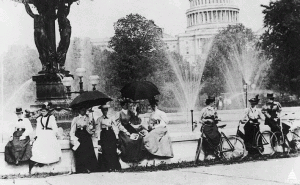 And then give them what they want. That’s one conclusion found in City Cycling (MIT Press 2012), which the Rutgers Focus calls “a guide to the urban cycling renaissance underway in most countries of the western industrialized world.”
And then give them what they want. That’s one conclusion found in City Cycling (MIT Press 2012), which the Rutgers Focus calls “a guide to the urban cycling renaissance underway in most countries of the western industrialized world.”
The book, co-edited by professors John Pucher (from Rutgers ) and Ralph Buehler (Virginia Tech), contains 15 chapters on that renaissance, including one suggesting that women are an excellent indicator of how well a city promotes cycling. According to Pucher, “If you want to get people on bikes, ask women what they want and give it to them.”
Why? Because when you make the effort to allay women’s fears about safety, you wind up with a pretty functional bike infrastructure. And when you promote cycling’s “enormous health and environmental benefits” to women, men also get the message. (Not stated but also plausible: men respond well to feminine direction.)
A few statistics: In Denmark—where cycling is embraced the way Americans embrace not-cycling and not-walking—18 percent of all trips are by bike. And women lead the way. “Fifty-five percent of all bike trips by Danes are made by female riders, compared to 24 percent of all bike trips made by women in the U.S.” The Danish portrait mirrors what’s going on in the Netherlands; the “Dutch make 26 percent of all trips via bikes” with “more than half of those (56 percent) by women.” And as we noted previously, in central Amsterdam roughly 50 percent of all trips are by bike. Yes, half.
(You knew this but: In the United States just 1 percent of all trips are by bike.)
Among the key lady-luring safety measures cited by Pucher are “dedicated bike lanes,” especially when they are “physically separated from vehicular traffic.” Parking, which the Dutch have nailed, is also a consideration.
Also big: police enforcement of bike lane laws. According to the Focus, “studies find that bike lanes in New York City are blocked by motor vehicles 60 percent of the time, forcing cyclists to swerve in and out of moving traffic or to ride on sidewalks.”
Just to hammer home the obvious: bike lanes aren’t sweet little perks. They aren’t an elective, any more than roads or rails or runways. You have a congested cities filled with obese people who are burning fossil fuels. The easy and cheap solution is to promote biking. It won’t solve everything, but it’s a good tactic. And women will show you how to make it work.
Photo: Women with bikes enjoy the Bartholdi Fountain in its original location northwest of the Capitol on the National Mall in 1890 with the U.S. Capitol in the background. (Today the fountain is located in the U.S. Botanic Garden’s Bartholdi Park southwest of the Capitol), via the Architect of the Capitol, via Wikimedia Commons.









